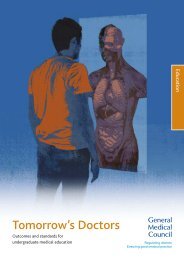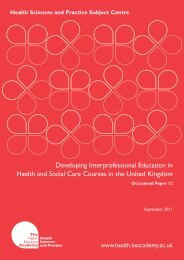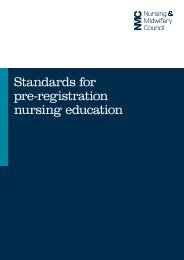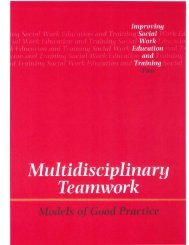(WHO) Patient Safety Curriculum Guide - CAIPE
(WHO) Patient Safety Curriculum Guide - CAIPE
(WHO) Patient Safety Curriculum Guide - CAIPE
Create successful ePaper yourself
Turn your PDF publications into a flip-book with our unique Google optimized e-Paper software.
Introduction<br />
The Multi-professional Edition of the <strong>Patient</strong><br />
<strong>Safety</strong> <strong>Curriculum</strong> <strong>Guide</strong> is a comprehensive<br />
guide to assist effective capacity building in<br />
patient safety education by health-care academic<br />
institutions. As patient safety teaching is relatively<br />
new for most health-care educators, the<br />
<strong>Curriculum</strong> <strong>Guide</strong> provides, in a single publication,<br />
educational frameworks and features a variety<br />
of concepts and methods for teaching and<br />
assessing patient safety.<br />
The present <strong>Curriculum</strong> <strong>Guide</strong> is designed to be<br />
easily integrated into existing health-care<br />
education curricula using a flexible approach<br />
to meet individual needs, and is applicable<br />
to different cultures and contexts. While it offers<br />
health-care schools and universities a<br />
recommended framework and resource materials,<br />
individual adaptations to local requirements,<br />
settings, student learning needs and resources<br />
are encouraged.<br />
The development of the Multi-professional<br />
<strong>Curriculum</strong> <strong>Guide</strong> began in January 2010 and<br />
is based on the <strong>Curriculum</strong> <strong>Guide</strong> for Medical<br />
Schools, published in 2009. A core working group<br />
comprised of experts from international<br />
professional associations in dentistry, medicine,<br />
midwifery, nursing and pharmacy, as well as<br />
from the <strong>WHO</strong> regions, coordinated the work<br />
of reviewing the 2009 <strong>Curriculum</strong> <strong>Guide</strong>,<br />
assessing available scientific evidence, and<br />
rewriting sections as they would apply to dentists,<br />
midwives, nurses and pharmacists. They also<br />
provided multi-professional case studies to<br />
support interdisciplinary learning and actively<br />
fostered discussion among experts and authors.<br />
More than 50 international experts contributed<br />
to preparing this document. Authors, contributors,<br />
experts, and other professionals who actively<br />
participated and facilitated the work process<br />
are listed in the acknowledgements section at<br />
the end of the document.<br />
Sections of the <strong>Curriculum</strong> <strong>Guide</strong><br />
The document comprises two parts: Part A:<br />
Teacher’s <strong>Guide</strong>; and Part B: 11 <strong>Patient</strong> <strong>Safety</strong><br />
Topics. For convenience, the figures and tables<br />
are numbered to correspond to the part and<br />
the section in which they are presented.<br />
Part A is aimed at health-care educators.<br />
It supports them with knowledge and tools,<br />
and helps them develop the skills necessary<br />
for implementing patient safety education<br />
in their institutions. Part A provides a systematic<br />
approach to building institutional capacity.<br />
It offers background information on how to select<br />
and teach each curriculum topic, makes<br />
suggestions on how to integrate patient safety<br />
teaching, and provides techniques for exploring<br />
how this subject could fit into the institution’s<br />
existing curricula. Part A also highlights the<br />
educational principles that are essential to patient<br />
safety teaching and learning and proposes<br />
approaches for student assessment, as well as<br />
evaluation of the current patient safety curricula.<br />
The importance of faculty engagement as an<br />
essential component for maintaining the<br />
sustainability of the programme is emphasized<br />
throughout the document. At the same time,<br />
clear examples on how patient safety might be<br />
taught are provided throughout Part A.<br />
Part B addresses health-care educators<br />
and students. It contains 11 ready-to-teach,<br />
topic-based, patient safety programmes that can<br />
be used as a whole or on a per topic basis.<br />
The topics cover a wide range of contexts<br />
in which patient safety can be taught and learned.<br />
The 11 topics are:<br />
Topic 1: What is patient safety?<br />
Topic 2: Why applying human factors is important<br />
for patient safety.<br />
Topic 3: Understanding systems and the effect<br />
of complexity on patient care.<br />
<strong>WHO</strong> <strong>Patient</strong> <strong>Safety</strong> <strong>Curriculum</strong> <strong>Guide</strong>: Multi-professional Edition<br />
18













